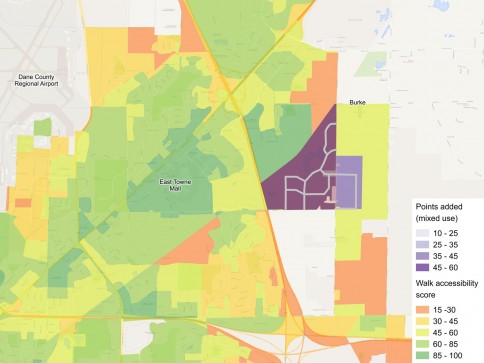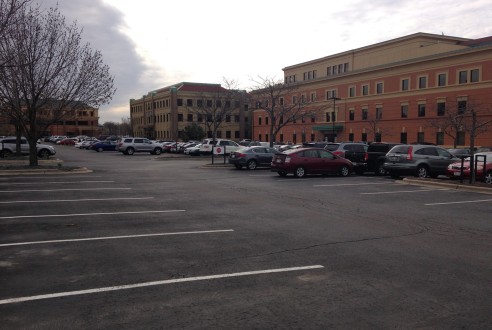Renewable Energy in the Right of Way
At SSTI’s first Sustainability Directors Community of Practice meeting in June 2015, attendees discussed their states’ interest in siting solar and other renewable energy generation facilities in the highway right-of-way but cited uncertainty regarding FHWA rules and unfamiliarity with the business side of renewable energy production as major hurdles. In an effort to support these efforts and allow interested states to learn from others, SSTI has gathered the technical documents gathered here, under the headings below, comprise a living repository for state DOTs and others to use as examples as they develop their own ROW renewable energy projects. Read More >
Trip-making and accessibility: New tools, better decisions (SSTI, 2016)
Transportation researchers and practitioners have long sought other tools to complement or perhaps replace conventional methods—tools that would better analyze trips rather than speed at points in the system, speak to non-auto modes of travel, address land use solutions as well as highway infrastructure, and so on. Fortunately, new sources of data and emerging methods, as well as new-found interest in performance and scenario planning, are yielding the types of tools that the field needs. Read More >
Effects of Parking Provision on Automobile Use in Cities: Inferring Causality (McCahill, Garrick, Atkinson-Palombo and Polinski, 2015)
Automobile use has been on the rise in cities for nearly a century and so has the supply of parking. Because driving often seems unavoidable, policymakers, developers and the public push endlessly for more parking to meet demand. That push, however, might only be making matters worse. SSTI Senior Associate Chris McCahill’s research suggests that abundant parking in cities causes people to drive more, shedding important light on the question of cause and effect. Read More >
FEATURED RESOURCE
Trip-making data, TDM, and connectivity in Northern Virginia (SSTI and Michael Baker International, 2016)
Commercially available GPS data offers valuable new insight about trip origins, destinations, and routes, including short trips that travel demand models often cannot capture. Using this data, SSTI worked with Michael Baker International, the Virginia DOT, and local stakeholders to identify opportunities for managing travel demand and improving connectivity throughout Northern Virginia. This final report describes the full data set and 17 selected case studies, along with recommended projects and policies, estimated costs, and benefits for each. More Resources...NEWS
Crashes fuel U.S. death-rate increase
A new report from the Centers for Disease Control and Prevention, made headlines last week for showing a decrease in Americans’ life expectancy in 2015—a reversal of a decades-long positive trend. One element of the brief report is of special interest to transportation practitioners: The population-adjusted “unintentional injury” rate jumped by 7 percent, passing chronic lower respiratory diseases to rank No. 3 as a cause of death. Causes of unintentional injuries include crashes, as well as drug overdoses, falls and other less-common mishaps. Read More >
Automated vehicles will bring big highway capacity increases
As the transportation field grapples with the impending impacts of automated vehicles, one AV-related outcome seems clear: Highway capacity will dramatically expand. Because automatic braking systems react much faster than human drivers do, safe spacing on freeways can be reduced by about half. As a result, the current rule of thumb that a freeway lane can handle a flow of 2,000 vehicles per hour will be radically changed. Read More >
Virginia’s SMART SCALE helped Hampton Roads improve its transportation projects
The December 12 edition of the Daily Press features an editorial by Virginia DOT Secretary Aubrey Layne explaining how the state’s new project selection process, dubbed SMART SCALE, improved the way transportation projects are planned and developed. The editorial points out that regional leaders in the Hampton Roads area needed to be strategic about which projects were the most important and would score the best under SMART SCALE. This process lead to better, more thoughtful projects being submitted for the limited available state funds. Read More >
Providence, RI decides the future of a deteriorating freeway
Efforts to duplicate the urban freeway removal success stories of Milwaukee and San Francisco, both of which allowed valuable urban land to be redeveloped, face an uphill battle despite many boosters. The debate between urban boosters and state DOTs that control most urban freeways has recently come to Providence, Rhode Island, with the question of what do to with the 6/10 connector. Read More >
The quest for market share: Is Uber’s business model sustainable?
A new analysis of the scant information on Uber’s profits and losses—information normally confined to investor meetings at this privately held company—calls into question the long-term sustainability of the company. It also raises concerns about whether Uber will be the transportation solution that some cities and transit companies have looked for. Read More >



